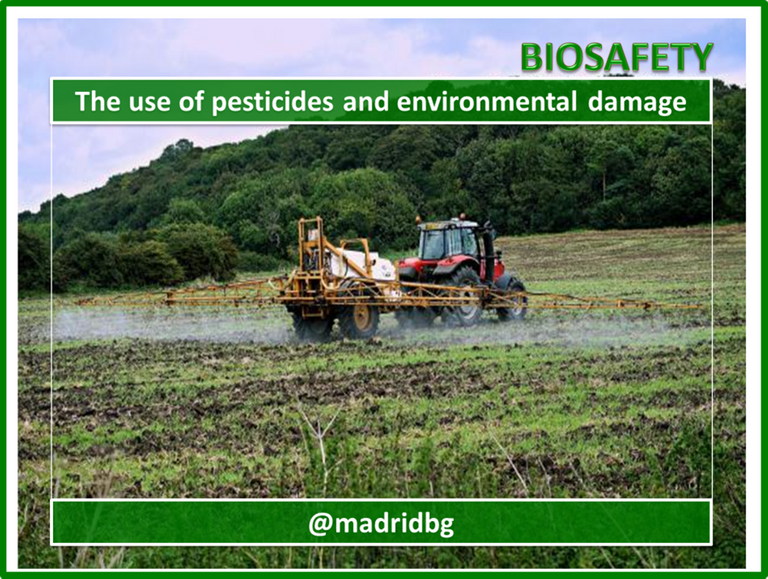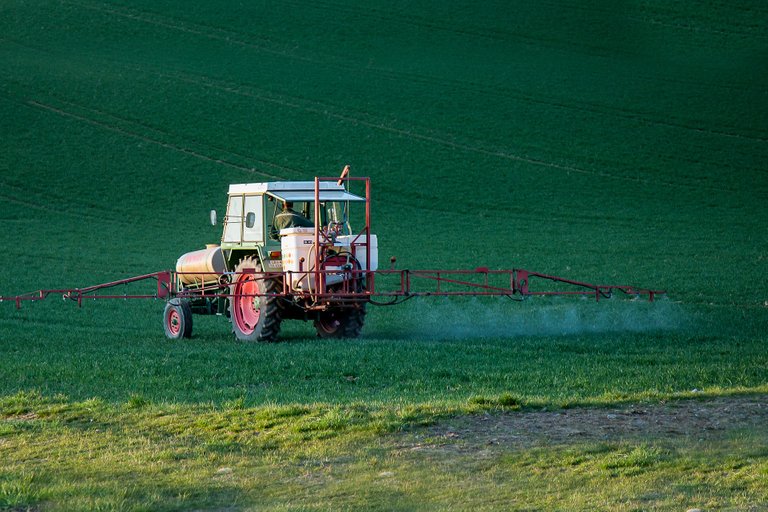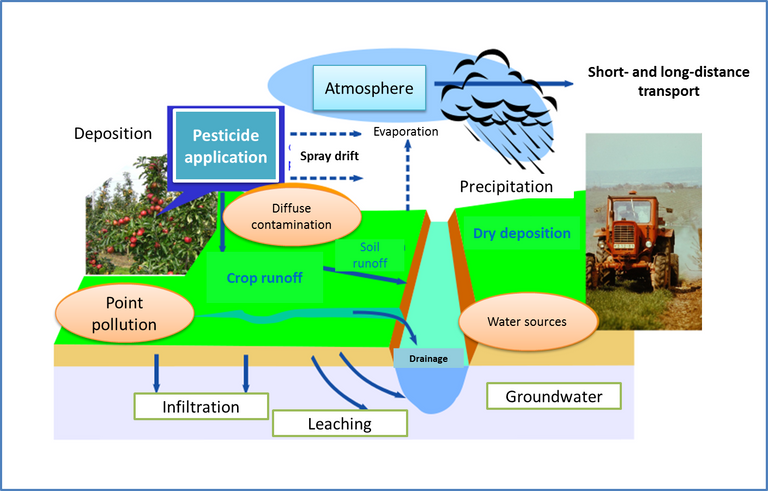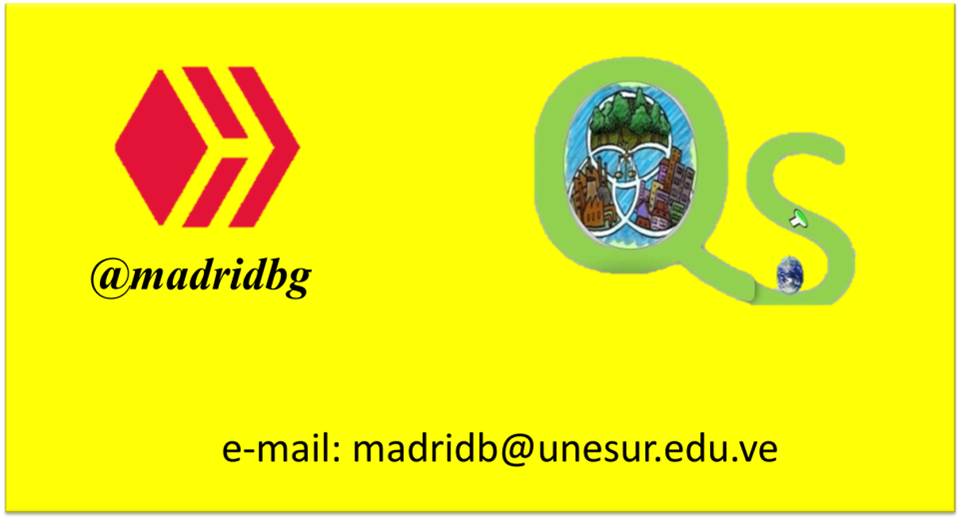BIOSAFETY // The use of pesticides and environmental damage
(Edited)

Author: @madridbg, through Power Point 2010, using public domain images.
Welcome back to all those users of the #Hive platform who are passionate about topics of environmental interest oriented to the preservation and care of our environment. This article will address the basic fundamentals of the use of pesticides at the health level and how these substances influence the degradation of our planet.
Information that we will share through the @ecotrain community who have been constant in the socialization of sustainable topics of interest.
INTRODUCTION
Man, in his eagerness to obtain a better quality of life, has been able to adapt to the circumstances and to evolve scientifically and technologically as a measure to achieve the development of the people. However, this ambition has allowed the emergence of a society that demands more and more goods and services (technology, clothing, toiletries, food, among others).
Consequently, the riches of our planet have been exploited in order to meet the demands of individuals, one of the main natural resources that man uses is the soil, through it has managed to obtain the food products we need to subsist so it demands optimal soils that meet the demands of society.
In this sense, it is necessary to elaborate bio-products that combat pests that threaten crops, a substance that has been observed since the early years of man's development, as there is evidence and documented data where sulfur was used as a purifying substance or pyrethrum flowers as an insecticide. However, with the advent of the industrial revolution these natural substances were replaced by synthetic products that perform the same function more effectively, but causing serious damage to our environment.
Therefore, it is appropriate to address through these lines of writing, from a scientific point of view, the use of pesticides and their repercussions on the environment.

Fig. 2. Over the years, these substances end up having serious consequences on health and the planet.. Author: Th G
GENERAL INFORMATION ABOUT PESTICIDES
As mentioned in the previous section, the demand, requirements and growth of society have forced us to use chemical substances that allow us to combat pests more effectively and dynamically, as a measure to protect crops. However, the use of these substances has contributed to the crisis in agriculture aimed at preserving the planet's ecosystems and natural resources.
The effects of these substances can be glimpsed at the level of urban and rural communities, where the levels of contamination and poisoning caused by these chemicals are more marked every day.
In this sense, FAO, 1990, defines pesticides as:
"Any substance or mixture of substances intended to prevent, destroy or control any pest, including vectors of human or animal diseases, unwanted species of plants or animals that cause damage or otherwise interfere with the production, processing, storage, transport or marketing of food, agricultural products, wood and wood products or animal feed, or that may be administered to them to combat insects, arachnids or other pests in or on their bodies.”
Under this conception we can find more than 30 thousand types of these substances, which we can classify according to their origin in chemical or biological, the former being the ones that have caused the most damage to our environments. On the other hand, according to their toxicity, there is a sub-classification that we will deal with in detail in the following contribution.
Particularly, the danger of these substances is attributed to the fact that they dissipate very little, which is why they can remain in our environment for long periods of time. Likewise, some of these substances, due to their lipidic nature, can enter the trophic or food chain through animals and accumulate progressively in living beings, which generates long-term physiological effects.
CLASSIFICATION OF PESTICIDES ACCORDING TO WHO AND THEIR MOST FREQUENT USES
When talking about pesticides we must take into account that there is an extensive classification and according to the type of organisms to be controlled we can classify them as larvicides, formicides, pulgicides, garrapaticides, nematicides, molluscicides, among others, we can also organize them according to their chemical composition in organophosphates, organochlorines, carbamates, among others.

Fig. 3. Pests are harmful but there are artisanal methods to combat them without harming the planet. Author: Petra Göschel
However, according to the guidelines of this publication, we will focus on the classification according to the toxicity levels of these substances and we will describe them below:
1. Class A pesticides: they are considered as extremely toxic substances, so it is necessary to avoid contact with the skin or any other organ of the body, its manipulation goes according to attachments. This type of compound has a LD50 of less than 100 mg/kg body weight.
2. Class B pesticides: This type of substance requires the same treatment as class A, the difference lies in the LD50 levels, which range between 101 and 300 mg/kg body weight.
3. Class C pesticides: These are products of less toxicity than the previous ones, LD50 levels vary between 301 and 1 000 mg/kg weight, they must also be handled with care, avoiding contact with the skin and respiratory tracts.
4. Class D pesticides: These are the least toxic and have a LD50 greater than 1000mg/kg of weight, although their toxicity is considered low, the regulations for handling this type of substance must be complied with.
Undoubtedly, the substances used in pest control are multiple and varied, where agricultural activities consume more than 85% of these products, the reality is that they cause substantial benefits although they have negative repercussions on the environment.
EFFECTS OF PESTICIDES ON THE ENVIRONMENT
The ecological problems caused by pesticides are varied and are attributed to the constant use in soils, accidental spills, inadequate use, among others, actions that generate a distribution of these substances that when they come into contact with rainwater, reach the oceans, lakes and rivers due to the runoff generated, threatening the stability and balance of biotic systems since part of these substances are absorbed by the species, accumulate and can reach lethal concentrations for them and for the species that depend on them.
Similarly, an alarming situation is also observed in the air, since when substances are released by air dispersion, the particles can travel long distances, reaching urban and rural areas and disturbing the health of the inhabitants.
On the other hand, the soil is the one that acquires the highest concentration of these substances, although many microorganisms degrade their persistence can exceed 5 years according to the type of chemical compounds that contain the pesticide.

Fig. 4. Systems affected by the distribution of pesticides. Author: Scann, 2020
Therefore, we can observe the scope of this type of compounds, which not only attacks the pests for which it was designed, but indirectly compromises the welfare of our planet.
CONTRIBUTIONS OF THE SUBJECT
Through this publication we were able to address the use of pesticides, its classification and the levels of affections that it generates in our environment, so we can establish that more than a benefit, chemicals tend to do a harm that threatens the ecosystems of our planet.
BIBLIOGRAPHY CONSULTED
[1] Barreto, L. et al., 2013. Eutrophication in Brazilian rivers. Encyclopedia Biopedia, 9(16), p. 2179. Article: Online Access
[2] Bedmar Francisco. School of Agricultural Sciences. National University of Mar del Plata. Special report on agricultural pesticides. Article: Online Access
[3] Ome Barrera, Ó.; Zafra Mejía, C. (2018). Key factors in bioremediation processes for wastewater treatment. A review. Magazine U.D.C.A Actualidad & Divulgación Científica under a Creative Commons CC BY-NC 4.0 license. Article: Online Access
[4] Ramírez L y Martinez J. FATE OF PESTICIDES IN THE ENVIRONMENT. A CASE OF STUDY FOR THE PROGRAM FOR SUPPORT TO PROJECTS FOR INNOVATION AND IMPROVEMENT OF TEACHING AT UNAM. UNAM, Faculty of Chemistry, Department of Chemical Engineering, Environmental Chemical Engineering and Environmental Chemistry Laboratories. Article: Online Access
OF INTEREST
•


0
0
0.000
#posh twitter
https://twitter.com/BGMadrid/status/1356588433527955456?s=20
Congratulations @madridbg! You have completed the following achievement on the Hive blockchain and have been rewarded with new badge(s) :
You can view your badges on your board and compare yourself to others in the Ranking
If you no longer want to receive notifications, reply to this comment with the word
STOPCheck out the last post from @hivebuzz: